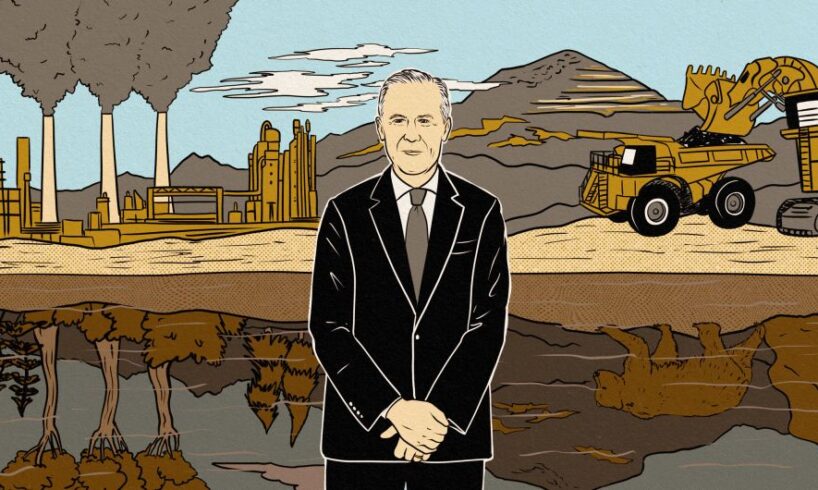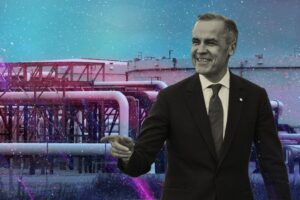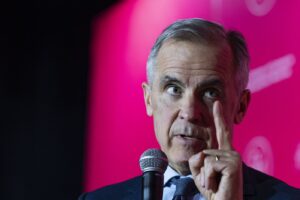
A decade ago, Mark Carney gave a rousing speech about the power of governments to change course before climate-driven chaos shifted into truly unpredictable territory.
At the time, Carney was speaking to insurance market Lloyd’s of London, in his former role as governor of the Bank of England. He began by acknowledging how insurers had been “dealing with the reality” of climate change for years, as they watched damage from storms, floods and other weather events triple since the 1980s and soar in costs by billions of dollars.
But whatever the challenges posed by climate change, Carney said, they paled in comparison with what looms ahead. Science had already shown the planet was approaching the limits of what carbon pollution it can absorb before severe and irreversible consequences occur. It was clear humanity needed to reduce fossil fuel production and use, to halt global warming at the scientifically significant threshold of 2 C above pre-industrial levels.
So why wasn’t more being done? He argued it was because business and political leaders, focused on the issues of the day, had no incentive to fix a problem that would have its greatest impact on future generations, a paradox he dubbed the “tragedy of the horizon.”
“It is governments who must choose whether, and how, to pursue that two-degree world,” Carney said.
Today, Carney is leading one of those governments. He can choose to pursue that two-degree world with gusto. But he, too, has found himself consumed with responding to the many crises of the day — to the detriment of climate action.
Canada won’t meet its 2030 emissions target, the Canadian Climate Institute said last month, and recent federal and provincial policies aren’t helping. The institute said two of Carney’s decisions as prime minister — repealing the consumer carbon price and delaying electric vehicle sales targets — threatened Canada’s climate progress.
The planned expansion of liquefied natural gas (LNG) production in Canada, something Carney’s government is encouraging by designating one project in the “national interest” and cheering on another, could also “lock in emissions-intensive growth for years to come,” the institute added. This could jeopardize even Canada’s next climate target, set for 2035.
One reason Canada is missing its targets is because of the oil and gas industry, which already accounts for the largest share of the country’s emissions. While other sectors like electricity and buildings have been cutting their emissions, federal figures show carbon pollution from the oilsands increased 480 per cent from 1990 to 2023, and natural gas by 37 per cent.
These days, the prime minister still talks about taking action to address climate change, and of the advantages of building a low-carbon economy. But he also talks about Canada becoming an “energy superpower” not just with clean energy, but with “conventional,” by which he means oil and gas. When asked by reporters last month how he might adjust Canada’s climate targets, Carney said it was crucial to focus on “what can we do in order to drive emissions down in a way that makes the country more competitive.”
Then again, Carney has also been prime minister for less than a year, so perhaps his most significant climate actions are yet to come — for better or worse.
Here’s a running list of the decisions Carney has made that will influence how quickly we arrive at that two-degree world he heralded so many years ago.
Table of Contents
Mark Carney killed the consumer carbon tax [jump to section]
Mark Carney paused the electric vehicle mandate [jump to section]
Mark Carney named an LNG expansion project in the ‘national interest’ [jump to section]
Mark Carney named a nuclear reactor in the ‘national interest’ [jump to section]
Mark Carney passed a law that puts pressure on green rules (and Indigenous Rights) [jump to section]
Mark Carney killed the consumer carbon tax
For years, Canada’s price on carbon pollution could be thought of as supported by two pillars. One pillar, still in place today, applies to big industrial polluters and operates like a trading scheme, with emissions limits that facilities require credits to breach.
Carney knocked down the other pillar on his first day in office, March 14. That branch had applied a fee to the sale of fossil fuels like gasoline and sent out the proceeds in the form of rebate cheques, divided among taxpayers. The value of the cheques didn’t change, so by spending less on fuel, Canadians could pocket the difference. Most households got back more than they paid.
But Carney entered the Liberal Party leadership race after the Conservative Party had engaged in a years-long campaign against the so-called carbon tax. Many Canadians strongly associated the policy with former prime minister Justin Trudeau, and “axe the tax” signs and bumper stickers had become a common sight across the country. Sensing the political winds had irrevocably shifted, Carney ditched his predecessor’s policy the first chance he got.
That move is projected to add roughly 20 million tonnes of carbon dioxide equivalent to the atmosphere by 2030, the Canadian Climate Institute has said.
(Back to top)
Getting gasoline-powered cars off our roads would help residents in high-traffic areas to breathe easier. But Canada’s transition to electric vehicles might move more slowly now that Prime Minister Mark Carney has paused a Trudeau-era policy that mandated electric vehicle sales. Photo: Katherine Cheng / The Narwhal
Mark Carney paused the electric vehicle mandate
Almost half of Canadians live near high-traffic areas, as well as half our schools and half our long-term care facilities. This exposes many of us to harmful air pollutants from exhaust fumes, as well as things like nitrogen oxide and carbon monoxide which can worsen asthma symptoms and raise the risk of lung cancer. Not to mention that the transportation sector is the second-largest source of emissions after oil and gas.
Getting more tailpipes off the road may not alleviate our monster traffic jams or fix our car-brained suburbs, but at least it would help us all breathe easier. That’s one reason why the Trudeau government put in place Canada’s Electric Vehicle Availability Standard, which is supposed to slow the tsunami of brand-new, gasoline-burning vehicles that roll into showrooms every year.
Under the program, when automakers sell new cars, SUVs and pickup trucks, at least 20 per cent of them would have to be “zero-emission vehicles,” a government category that includes both fully electric cars and plug-in hybrids that can run for a short time on batteries before its gasoline engine kicks in. That percentage then rises over time to 2035 when all new sales would fall into this category.
The sales targets were to begin for the 2026 model year, but on Sept. 5, Carney stopped it from going ahead, and instead launched a review of the program. His government said it was exploring other options to “bring more affordable electric vehicles to Canadians.”
The prime minister’s decision came after lobbying from the automotive industry over the summer. During his announcement, Carney framed the move as part of his response to U.S. President Donald Trump’s tariffs. He said the auto sector was “under extreme pressure.”
“They’ve got enough on their plate right now. So we’re taking that off,” he said.
(Back to top)
The LNG Canada megaproject recently came online in Kitimat B.C., sending its first liquefied natural gas shipment to Asia in June. Now, Prime Minister Carney has deemed a proposed expansion of the facility as a “nation-building project” that should be prioritized. Photo: Marty Clemens / The Narwhal
Mark Carney named an LNG expansion project in the ‘national interest’
LNG Canada is a megaproject in Kitimat, B.C., that exports liquefied natural gas or LNG, a fossil fuel made up primarily of the greenhouse gas methane. The project is owned by a consortium of multinational and state-owned oil and gas companies including Shell and PetroChina.
The process to produce and export liquefied gas is hugely energy intensive. First, companies drill underground for gas, often by hydraulic fracturing, or fracking, where they inject water and chemicals into deep rock formations, creating cracks that release gas. Then the gas is cleaned up, compressed and pumped through pipelines to a facility where it’s cooled into a liquid state at roughly -160 C and loaded onto tankers to ship overseas. When a tanker arrives at its destination the fuel is turned back into gas, put into more pipelines and sent to other facilities where it’s burned for energy.
Scientists have shown that methane gas, which worsens climate change, leaks into the atmosphere at many points along this process — from fracking to processing, transport and storage. Peer-reviewed research indicates that, in some cases, all this leaking can make total greenhouse gas emissions from liquefied natural gas worse than coal.
On June 30, LNG Canada sent its first shipment to Asia, but the project has big plans to expand. Phase 2, as it’s known, would double the facility’s production and transform it into the second largest of its kind anywhere in the world. It would also explode Canada’s emissions: at full capacity, it would produce around 13 million tonnes of greenhouse gas emissions each year, or more than a fifth of B.C.’s entire emissions profile in 2020.
While the consortium is debating a final investment decision on that phase, on Sept. 11 Carney gave it a huge push by listing Phase 2 as one of Canada’s first “nation-building projects” under the Building Canada Act, part of Bill C-5. That law lets the project skip some legal and regulatory requirements for things like environmental reviews and permits. Carney said Phase 2 was expected to “attract significant private-sector capital,” contribute to economic growth and support jobs.
(Back to top)
Mark Carney prioritized a nuclear reactor in the ‘national interest’
On the north shore of Lake Ontario, just east of Toronto, lies the Darlington Nuclear Generating Station. This power plant can generate around 20 per cent of Ontario’s electricity supply but its four aging reactors have been undergoing a refurbishment program since 2016, set to be completed by next year.
Now, there’s a plan to add four more reactors. A consortium of Canadian construction company Aecon and engineering firm AtkinsRéalis (formerly known as SNC-Lavalin) and U.S.-Japanese alliance GE Vernova Hitachi is gearing up to build a small modular reactor or SMR, a new type of technology where reactors are prefabricated and transported to the site to be installed. It would be the first small modular reactor of its kind to be built in North America.
Ontario Power Generation, a Crown-corporation wholly owned by the province, wants to install four of those prefabricated reactors at the site, and Ontario Premier Doug Ford’s government gave the $21-billion plan its approval in May. Following suit, on Sept. 11 Carney put the reactors on his list of “nation-building projects,” saying they “could support Canadian and global clean energy needs,” sustain thousands of jobs and drive millions of dollars into the economy.
Nuclear plants are non-emitting, so once the plant is built and operational, it would not be belching out greenhouse gas emissions while it’s creating power — unlike Ontario’s natural gas plants. But other aspects of the nuclear energy supply chain do create emissions, like the mining, refining, enriching and transporting of uranium.
Critics also say the huge cost of nuclear and long timelines — the first new reactor at Darlington isn’t expected until 2030 — don’t make sense when solar and wind energy options are cheap and quick to build. Plus, there’s the tricky issue of where all that nuclear waste will go. Canada already has a stockpile of radioactive refuse from existing generators and a plan to bury it near the northern Ontario town of Ignace has received pushback from some First Nations representatives.
(Back to top)
Mark Carney passed Bill C-5, a law that allows environmental assessments to be trimmed
Building big things in Canada has always been hard, but the Conservative Party and some business leaders have been arguing the country lost its ability to get anything big over the finish line. The oil and gas industry in particular has lobbied against environmental regulations it views as having a chilling effect on new projects.
After the Trudeau government was elected in 2015, it tried to address the issue of projects getting stuck in the courts, by passing a law known as C-69 that was meant to address environmental and Indigenous concerns up front. But the law’s deep planning and review process, which can take years, only inflamed tensions with some provinces. This year, in the wake of the U.S. threatening Canada’s sovereignty, there has been strong support for a government that knocks down barriers to build up the economy within Canada, rather than relying on our neighbour to the south.
Enter Carney, who has tried to seize the opportunity to, in his words, “build, baby, build” by passing Bill C-5, the One Canadian Economy Act, on June 26. That law allows projects deemed by the government to be in the “national interest” to bypass certain rules, including parts of the impact assessment process that had been set up by C-69. It does this by automatically granting these “national interest” projects all of the permits and approvals they’d normally require, in one fell swoop.
The point of the federal impact assessment process is to examine the positive and negative effects that proposals could have on the environment, communities and Indigenous Rights. But it also allows for public involvement in projects before they’re built.
The Supreme Court of Canada has been clear for decades that Canada’s laws require the government to go beyond simply telling Indigenous Peoples what’s about to happen on their lands. Several First Nations have expressed concerns about how Bill C-5 could infringe on their rights. Carney held summits with First Nations, Inuit and Métis leaders about the law, and says his decisions will be guided by an Indigenous Advisory Council — which has also been criticized as not representative enough of First Nations.
(Back to top)





